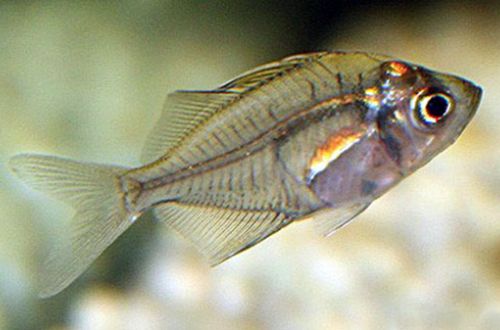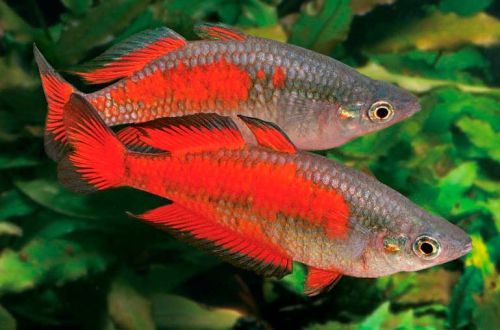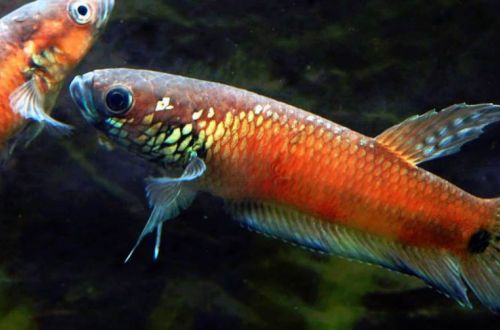
glass perch
The Indian glass perch, scientific name Parambassis ranga, belongs to the Ambassidae family. One of the most famous, but not very common species. He gained fame due to the fact that in Asia this perch is often artificially colored, but in very barbaric ways, which is condemned in Europe and America. Without this coloration, the fish is not so colorful, in addition, it is considered difficult to keep due to high mortality. But the last is the consequences of staining. An ordinary glass perch is hardy and unpretentious, gets along well with other fish and can be recommended to a novice aquarist.

Contents
Habitat
They originate from the territory of Southeast Asia, as well as India and Pakistan. They live everywhere in rivers, streams, lakes, swamps, etc. They prefer regions with dense aquatic vegetation and slow flow or stagnant water.
Brief information:
- The volume of the aquarium – from 80 liters.
- Temperature – 20-30°C
- Value pH — 6.5–8.0
- Water hardness – soft to hard (8-20 dGH)
- Substrate type – any dark
- Lighting – subdued
- Salty water is acceptable in weak concentration
- Water movement is weak
- The size of the fish is up to 8 cm.
- Food – any food
- Temperament – peaceful
- Keeping in a flock of 6 individuals together with other species
Description
Adult individuals reach a length of about 8 cm. Males, unlike females, have a blue edging on the dorsal and anal fin, there are more yellow shades in color. The differences are more apparent during the spawning season when the colors become more intense. A characteristic feature of the species is their translucent color. Internal organs are clearly visible through the integument of the body.
Food
Fish that are unpretentious in their diet will accept most popular dry, frozen and live foods of a suitable size. For example, a good combination is obtained from flakes and bloodworms, brine shrimp.
Maintenance and care, arrangement of the aquarium
The optimal size of the aquarium for a small flock of fish starts from 80 liters. The design uses a dark substrate, various driftwood and many rooted and floating plants. The latter serve as an additional means of shading to a subdued level of illumination.
Success in keeping is determined by the ability to maintain high quality water with the required parameters. This requires the installation of a productive filtration system and mandatory procedures such as cleaning the aquarium of organic waste and weekly replacement of part of the water with fresh water. Since the filter is the main source of water movement in the aquarium, when choosing a model, give preference to one that does not cause excessive flow.
Behavior and Compatibility
Peaceful shy species, prefers to stay in a flock of 6 individuals. During the mating season, males become territorial, but this does not lead to skirmishes or even more injuries. Compatible with non-aggressive fish of comparable size. Good neighbors will be representatives from the region of Southeast Asia.
Breeding / breeding
Breeding is quite simple and does not require the creation of special conditions. However, growing fry is not so easy. With the onset of the mating season and in a favorable environment, the fish form temporary pairs. It is possible to determine that spawning time will come soon by males, as noted above, their coloring becomes more intense. A couple lays eggs among plants, in total there are up to 200 eggs in a clutch. Parental instincts are weak, so immediately after spawning, fish can eat their own offspring. In order to preserve it, it should be carefully transferred to a separate tank with identical water conditions. They are very susceptible to fungus. To combat it, a weak concentration of methylene blue is often used, but it must be used carefully. More information about this problem can be found on the page “Fungal plaque on eggs”.
The fry appear the very next day, but begin to swim freely only after 3–4 days. At first, they feed on the remains of their yolk sac, then they can switch to microscopic food, such as brine shrimp nauplii.
Fish diseases
If the fish is of a natural color, that is, not artificially colored, then there are no health problems. Diseases are only the result of improper maintenance, leading to a weakening of the immune system and the body does not cease to resist infections. Read more about symptoms and treatments in the Aquarium Fish Diseases section.





